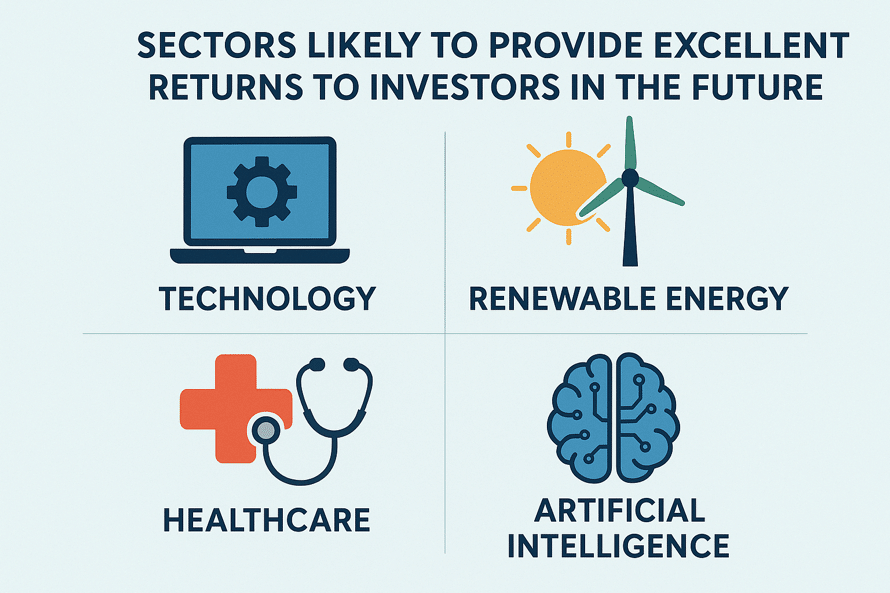
Many opportunities exist in the dynamic world of investment across various fields. Identifying these industries early positions investors for significant gains. Specific sectors stand out as high-potential investment opportunities due to structural trends, policy support, and innovation.
Technology & IT Services, Renewable Energy, Electric Vehicles (EVs), healthcare and pharma, fintech, defense and aerospace, consumer goods and FMCG are some of the sectors likely to provide excellent returns in the years to come. This blog post discusses some of these promising sectors.
Technology and IT Services
India’s economy is fast-growing, thanks to technological advancements, including digital transformation, artificial intelligence, cloud computing, and automation. However, as global demand increases, the sector experiences a surge in investment opportunities.
Growth Drivers in the Indian IT Sector
India’s IT services industry is expanding as digital transformation, cloud computing, cybersecurity, and AI adoption drive growth. Enterprises worldwide are transitioning from legacy systems to modern platforms, with Indian firms playing a significant role in this shift. IT services players drive AI and data analytics work, supporting growth projections.
Impact of Digital Transformation and AI
Digital transformation isn’t simply a term; it’s a phenomenon that is happening globally. Companies adopt automation, cloud computing, and AI-based decision-making technologies. Consultancy, integration, and managed services are rising. Besides, cybersecurity issues and the rise of generative AI highlight India’s status as an emerging technological hub.
Key Players and Market Opportunities
IT companies leverage their global distribution networks, tapping into immense talent pools and significant R&D expenditure capabilities to capitalize on opportunities. The Big Four IT firms are Tata Consultancy Services (TCS), Infosys Ltd, Wipro Ltd, and HCL Technologies Ltd., while Tech Mahindra, LTIMindtree Ltd, and MPhasis Ltd are included in the mid-cap category. Agile AI startups are revolutionizing the industry, but established companies still hold an advantage when it comes to complex business deployments. A well-diversified mix of investments in both large, well-established companies and small, innovative ones can fetch substantial returns.
Renewable Energy
India accelerates its shift toward renewables as it confronts climate change and energy security challenges. Therefore, renewable energy is among the sectors likely to provide excellent returns through solar, wind, storage, and related infrastructure.
India’s Renewable Energy Targets and Policies
India has achieved a significant milestone in its installed electricity capacity from non-fossil sources, surpassing the target set in the Paris Agreement. The government drives its ambitious renewable energy goals through output-based incentives, green bonds, and state-level initiatives that work in collaboration.
Investment Opportunities in Solar and Wind Energy
Private companies drive the growth of solar farms, wind parks, and storage facilities. Meeting India’s clean energy goals demands substantial investment in solar, wind, grid upgrades, battery systems, and hydrogen infrastructure. Besides, global collaborations and sovereign green bonds enhance the financial viability of these large-scale projects.
Leading Companies in the Sector
Adani Green Energy Ltd., Suzlon Energy, and Waree Renewable Tech Ltd, are some of the largest renewable energy companies in India, leading the way in expanding clean energy capacity. Also, organizations like the Indian Renewable Energy Development Agency (IREDA) aggressively finance renewable projects.
Electric Vehicles (EVs)
EVs are transitioning from early adoption to scale, both globally and in India. As clean-energy power converges with EV infrastructure, the industry is among the sectors likely to provide excellent returns.
Government Initiatives and Subsidies
The National Electric Mobility Mission and PLI programs for batteries drive the production and adoption of electric vehicles. Fiscal incentives, lower GST, and subsidies drive production and boost consumer uptake. These measures establish a robust domestic EV supply chain and position India as a global hub for clean mobility solutions.
Infrastructure Development for EVs
India is developing charging networks, battery-swap infrastructure, power upgrades, and smart grids to sustain momentum. Additionally, green hydrogen and innovative storage systems also strengthen the EV ecosystem. These projects make the energy system more resilient, lessen our reliance on fossil fuels, and help create a greener future for transportation.
Major Players in the Indian EV Market
Established automakers pivot toward electric models as start-ups and legacy players partner with battery manufacturers and tech firms. Tata Motors and Mahindra & Mahindra Ltd are the leading EV manufacturers in India. Additionally, the supply chain is also growing rapidly, which presents numerous investment opportunities in cars, batteries, and charging infrastructure.
Healthcare and Pharmaceuticals
Demographics, rising incomes, and urbanization are driving secular growth in India’s healthcare and pharmaceutical sectors. Therefore, as the demand for medical innovation and services increases, these are among the sectors likely to provide excellent returns.
Rising Demand for Healthcare Services
The expansion of India’s middle class is driving the growth of hospital chains, outpatient services, diagnostic centers, and specialized treatments. Telemedicine and tailored healthcare models will become increasingly common, further amplifying the potential. More people are becoming aware of their health, and as a result, more individuals are obtaining insurance. This makes people want high-quality, easy-to-get healthcare in cities and towns.
Growth in Pharmaceutical Exports
India supplies a significant amount of generic drugs, vaccines, and APIs to the global market. The pandemic showcased Indian manufacturers as reliable suppliers. Besides, regulatory changes and enhanced manufacturing capability will drive continued export momentum.
Innovations in Biotechnology and Medical Devices
Biotech innovation clusters are emerging, driving progress in everything from gene therapy platforms to point-of-care diagnostic tools. Indian research and development, incubators, and ecosystem enablers accelerate the creation and commercialization of innovative medical devices.
Financial Technology (FinTech)
Digital payments and neobanking are revolutionizing the way people in India access financial services. Additionally, the rapid adoption and enhancement of new technologies make fintech one of the top sectors likely to provide excellent returns.
Digital Payment Ecosystem Expansion
Mobile wallets, UPI, and QR-based technologies play a crucial role in creating a unified digital payment system. AI-based technology makes financial services faster, safer, and more user-friendly. Fintech innovations ease access to financial services and transform how people and businesses operate, driving an increase in digital usage.
Emergence of Neobanks and Digital Lending
Digital ecosystems enable start-ups to utilize virtual banking models, micro-credit, and embedded finance. Partnerships with existing banks and collective licensing regimes enable companies to grow quickly and launch new products. This approach to collaboration makes the financial world more accessible to everyone, allowing those who lack access to financial services to receive the help they need.
Regulatory Support and Challenges
Regulators enable Open Banking, sandbox testing, and digital finance initiatives. Besides, concerns over consumer data protection, cybersecurity, and compliance hurdles persist. As frameworks mature, fintech delivers structural returns. Refining policies and fostering public-private cooperation will play a crucial role in striking a balance between innovation and accountability in the evolving financial ecosystem.
Defense and Aerospace
India aims for self-reliance in defense production, creating a compelling growth story in aerospace, defense electronics, and systems integration. Besides, as investments and innovation accelerate, defense emerges as one of the sectors likely to provide excellent returns.
Government’s Push for Self‑Reliance
The Atmanirbhar Bharat policy encourages the manufacture of defense-related items in India through the Make in India program. Additionally, easing the constraints on foreign direct investment (FDI) facilitates collaboration with local businesses and fosters innovation. This two-pronged strategy makes people more self-reliant, connects India to global military supply networks, and improves technology.
Increase in Defense Budget Allocation
Annual budgets across sectors—missile systems, radars, and drones—has expanded. Additionally, these changes also accelerate the development of a competitive local military manufacturing ecosystem that meets global standards.
Opportunities for Private Sector Participation
Increasingly, private companies are becoming involved in aeronautical design, electronics, military research and development, and the manufacture of goods for export. Besides, platforms using drones, space payloads, and integrated defense systems are growing and adding new functionalities.
Consumer Goods and FMCG
Urbanization, rising incomes, premiumization, and convenience trends shape India’s consumer landscape, creating fertile ground for FMCG growth. Therefore, as consumer demand diversifies and scales, FMCG stands among the sectors likely to provide excellent returns.
Urbanization and Changing Consumer Preferences
People have more disposable money in their hands and want more packaged, healthy, and high-quality goods. People are also becoming more interested in categories and brands that claim to be eco-friendly.
Growth in E‑commerce and Direct‑to‑Consumer Models
E-commerce sites expand their reach, particularly in fast-growing markets such as India. Brands utilize omnichannel and direct-to-consumer models to foster loyalty and gather valuable customer insights. Besides, logistics improve, digital payments facilitate, and personalized advertising enhance the online shopping experience.
Leading FMCG Companies in India
India is dominated by leading heritage players, with a crop of new challengers that all invest in R&D, branding, and rural presence. Hindustan Unilever Ltd, ITC Ltd, Nestle India, Britannia Industries, and Godrej Consumer Products are some of the leading FMCG companies in India. Besides, health-conscious, premium, and vegan brands are redefining old playbooks. This changing landscape reflects the evolution of consumer tastes, presenting new opportunities for innovation, segmentation, and differentiation.
Data Centers and Cloud Infrastructure
Cloud adoption, data sovereignty, and digital public infrastructure are driving rapid growth in data centers. Therefore, with increasing demand for secure and scalable digital storage, the data infrastructure sector ranks among those likely to provide excellent returns.
Surge in Data Consumption and Storage Needs
India’s data usage is scaling exponentially because of digital transformation, streaming, IoT, and government platforms. Besides, privacy regulations, including personal data localization mandates, drive the demand for local data centers.
Investments in Data Center Infrastructure
Global hyperscalers and domestic players invest heavily in hyperscale data centers and connectivity services. Therefore, partnerships between the government and the private sector, like the Madhya Pradesh-Submer deal, emphasize energy efficiency and sustainability.
Role of Cloud Services in Business Operations
Increasingly, businesses are utilizing IaaS, PaaS, and FaaS services. Besides, cloud-native models are the backbone of various software types, including AI/ML, finance, healthcare, and e-commerce. Data centers and cloud infrastructure are also important assets.
Conclusion
Policy, technology, demography, and urbanization are all moving in the right direction, which is suitable for many industries. Therefore, these are specific sectors likely to provide excellent returns and exhibit significant long-term potential. Significant industry shifts pose risks. Besides, investors can manage volatility and achieve long-term financial success by diversifying across new industries.
FAQs
1. Which sector is expected to provide the highest returns in the next decade?
Returns depend on timing and valuation, but Technology & IT Services and Renewable Energy stand out as notable exceptions. First, the digital revolution and AI drive it, while second, climate change and energy security structural measures support it.
2. How can investors diversify their portfolios across these sectors?
Investments in IT, renewable energy, EVs, healthcare, digital banking, military technology, consumer brands, and infrastructure balance conventional and thematic investments. Therefore, you can select ETFs, mutual funds, or direct shares across various sectors.
3. What are the risks associated with investing in emerging sectors?
New sectors face regulatory, technological, and execution challenges. Besides, clean-energy projects encounter land or grid issues; fintech faces compliance headwinds; defense sector relies on budget and geopolitical timelines. Thus, investors should stay attuned and diversify their portfolios.
4. How do government policies influence sectoral growth?
Subsidies, tariffs, PLI schemes, data localization requirements, and FDI constraints promote adoption and boost sectors likely to provide excellent returns. So, unexpected changes or policy reversals might produce volatility.
5. Are there any tax benefits for investing in specific sectors?
Absolutely. Green bonds, renewable energy projects, and government-backed infrastructure often receive tax exemptions. Additionally, certain sectors may qualify for customs or GST benefits under national schemes.







